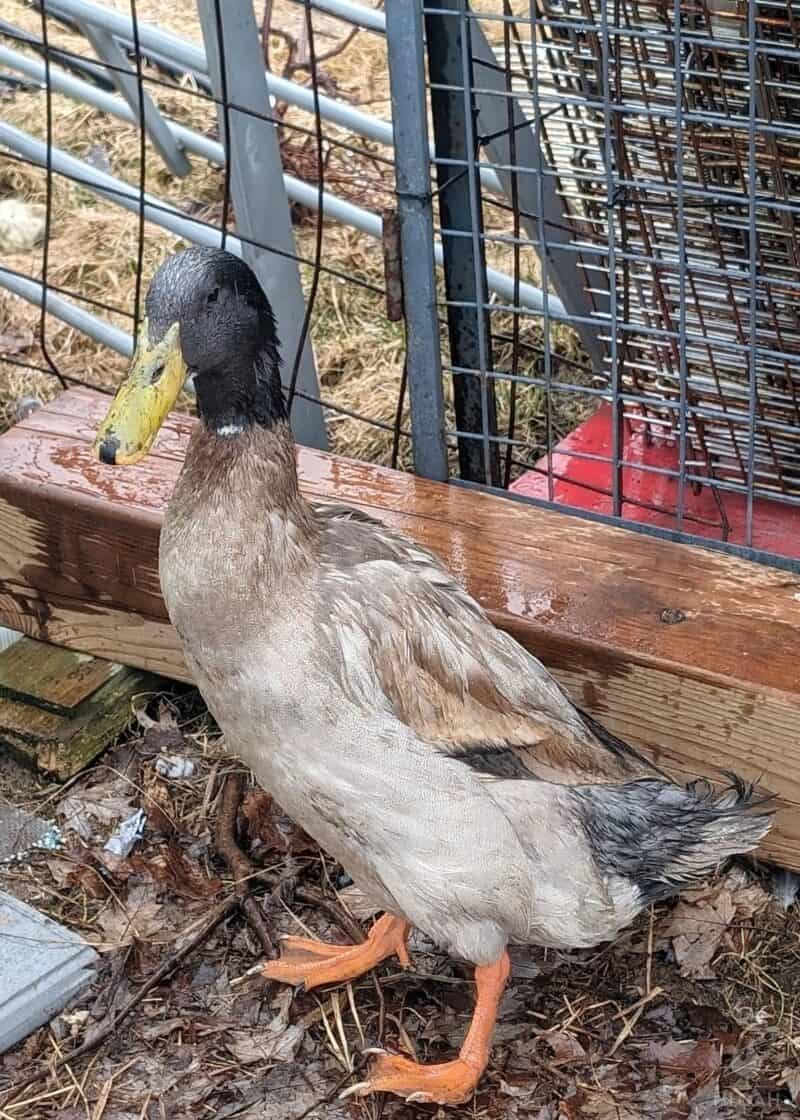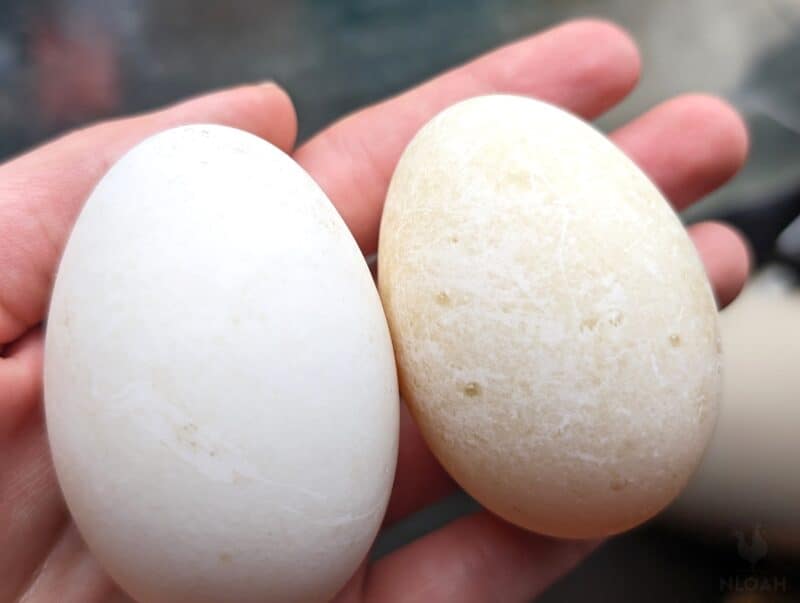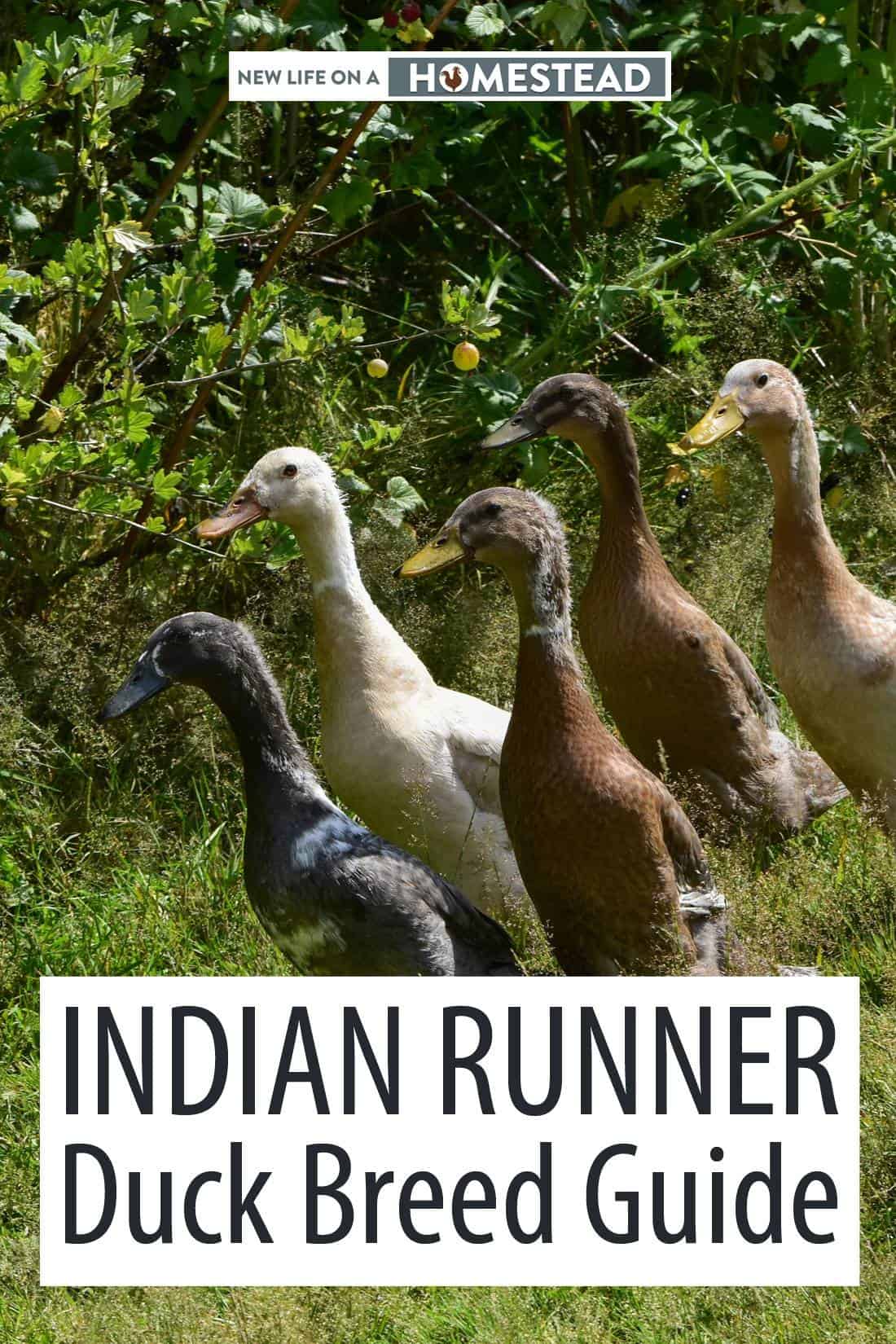Indian Runner ducks are perhaps the easiest of all breeds to identify due to their unusual body style. Watching these attractive poultry birds run about while free ranging can be quite entertaining.
They look like colorful penguins rushing around the barnyard. In fact, when members of this duck breed were first imported to America they were dubbed “Penguin Ducks.”

Ducks of this breed may look like the waterfowl equivalent of bowling pins with plumage, but they are actually excellent egg layers, and can even be bred and kept as meat ducks.
Indian Runners do not fly any better or worse than other domesticated duck breeds.
The small and short wings and heavy bodies allow domesticated ducks to lift just a few inches or so off the ground, and do a mock flying motion to propel themselves forward maybe one foot before thudding unceremoniously back down to the ground.
Members of this unique duck breed typically for 8 to 12 years when kept in sanitary and safe living conditions. In the wild, Indian Runner ducks never achieve such longevity and often perish in just 24 months.
History Of Indian Runner Ducks
This duck breed has been around for at least 2,000 years. Drawings or carvings of Indian Runner ducks have been found on ancient temples in the Javan region of Indochina. Flocks of this duck breed were also common in both Bali and India.
Flocks numbering into the thousands were routinely seen roaming in their native land of southeast Asia. Indian
Runner ducks were easily spotted running around on the islands, with duck herding being an early mainstay of local economies. It was not until the early years of the 1800s that Indian Runner ducks were exported from the Indonesian islands to Europe.
Duck herders in Indonesia would drive an Indian Runner flock of 1,000 on a long march to get them to market. The ducks would have to forage as they walked sometimes rugged trails to find food. Rice fields were among their favorite sources of sustenance.
As the Indian Runner flock was herded to market, the duck herders would also collect all of the eggs they dropped to both eat along the way, and to sell upon their arrival. The trek to a village market could take as long as six months when the Indian Runner duck keepers lived in a remote area.
While some to many Indian Runner ducks perished along the way, those that did make it to market and become breeders in a new flock helped to foster this breed as one of the most disease resistant and hardy.
Indian Runner ducks are often crossbred with other breeds to help infuse their hardiness and attractive feathering into a flock. These ducks went nearly extinct (especially in Western Europe and Britain) during the 16th Century due to extensive crossbreeding.
They were also used in crossbreeding efforts to create both the Khaki Campbell and Buff Orpington duck breeds.
It wasn’t until the beginning of the twentieth century, in the early 1900s, that fresh importations of these domestic ducks were made, and the breed’s popularity as a separate, distinct breed was fully renewed.
Physical Characteristics Of Indian Runner Ducks
- The Indian Runner duck body is highly cylindrical in shape. It stands erect and upright just like the body of a penguin. Their bodies are both very slim and long.
- The legs on an Indian Runner duck are set back further than they are on most if not all other duck breeds. The leg placement helps stabilize the unusual body shape so they can actually run very quickly and not waddle like a penguin.
- Tails on ducks of this breed are highly compact, again making them distinct from most other varieties of ducks.
- Indian Runner ducks stand approximately 20 to 26 inches from the top of their crown to the end tip of their tail.
- Indian Runner duck heads are wedge-shaped.
- The bills on ducks from this breed are incredibly straight.
- Eyes on ducks of this breed are positioned high on their heads.
- Drakes (males) weigh about three and a half to five pounds once they mature.
- Mature Indian Runner duck hens (females) often weigh roughly 3 to just over 4 pounds (around 1.5 kgs). This is a comparatively small size for ducks.
- Indian Runner ducks come in a fairly vast color array – more so than many other domesticated duck breeds. Ducks of this breed often have plumage in shades of blue, chocolate, brownish green, black, light brown, white, and dark brown. The most common color is the brownish shade of green, white, chocolate, and black.
Egg Production
Indian Runner Ducks are some of the best egg-laying ducks you can raise, offering high egg production compared to other flocks of ducks.
- A mature Indian Runner duck hen will lay roughly 300 to 350 eggs per year.
- Duck hens of this breed lay large eggs in hues of both blue and white.
- Indian Runner duck eggs typically weigh between 2.8 and 3 ounces.
- A hen of this breed will usually lay with both good quality and quantity for 4 to 5 years before the quantity starts to decrease with age. These prolific layers are consistent!
- Unlike Pekin ducks, the Indian Runners do favor mating in the water, or when it is raining. Duck mating can be quite rough on the hens, especially when the mating occurs in the water where accidental drowning can occur.
- It would be highly unusual for an Indian Runner duck hen to turn broody. A hen of this breed typically sits her eggs to hatching fairly well, but investing in an incubator will help ensure flock sustainability.
- Even if an Indian Runner hen chooses to sit her eggs until they hatch, she will likely believe that her motherly duties are then complete. Hens of this breed rarely exhibit real maternal instincts. You may need to place the ducklings in a brooder to keep them safe from trampling or wing pulling by more mature members of the flock.
Meat Production Of Indian Runner Ducks
This domesticated duck breed is classified as being light class. It is uncommon to raise Indian Runners as meat birds commercially because they do not put on weight rapidly like Pekin or Buff Orpington ducks – nor do they get as large. But, residential keepers can surely harvest ducks of this breed for their dinner plates.
I would compare the taste of meat produced by Indian Runner ducks to that of wild duck – it is quite flavorful and not very greasy. These ducks produce little fat. A mature Indian Runner duck, be it a drake or a hen, should offer enough meat to feed up to two adults.

Husbandry Hints And Tips
Indian Runner ducks will forage, but only close to their duck house or coop and run. Unlike their ancestors who wandered far with just a little work by their herders, modern flocks prefer to remain close to familiar spaces unless directed elsewhere.
Expect ducks of this breed to only find up to one third of their daily dietary needs through foraging – unless you use a chicken tractor to relocate them to specific areas to find more insects and wild greens after the ones near their living quarters have been eliminated.
Foraging favorites of Indian Runner ducks include: small fish, tadpoles, small frogs, slugs, wild greens, insect larvae, mosquitoes, and snails.
Members of this duck breed can be kept entirely in a coop and run environment, but it will have to be a spacious one. Even though they do not ever roam far unless forced to, they prefer the freedom of movement to caged life.
Provide a minimum of four square feet per Indian Runner duck if they will always or primarily be kept in a coop and run.
In the coop, always provide these animals with plenty of clean bedding. This can help to reduce the likelihood of illness.
Even though their cylindrical-shaped bodies might not indicate Indian Runner ducks are avid or graceful swimmers, they truly are. When allowed, ducks of this breed prefer to spend at least half of their time in water.
A pond or plastic baby pool will need to be placed where the flock has constant access to them to avoid stress and ample vocalized displeasure from these poultry birds.
These ducks seem more bothered by some other duck breeds. Worms can be the most common parasitic problem for members of this duck breed.
Indian Runner juvenile and mature ducks should be wormed after purchasing if you cannot verify it has already been completed by the seller. Worming the flock members every three weeks for the first two months of keeping and again once every six months is highly recommended.
It is also a good idea to dust the head of the ducks about once a month to better protect them from mites. You can purchase the poultry bird dusting material from an agricultural supply store like Rural King or Tractor Supply.
I prefer to make my own natural dusting material and herb balls to protect all of my poultry flocks from mites and worms:
- Simply combine equal parts of sage, garlic, cinnamon, oregano, basil, thyme, and clove to dust the heads.
- Stir in enough raw natural honey and a pinch of bread to make a paste with the spices to create herb balls to serve as a parasite-fighting treat.
Can Runner Ducks Survive Winter?
Indian Runners are a substantially hardy breed. They adapt quite well to both cold and hot climates.
Indian Runner ducks are capable of surviving winter temperatures as low as 0F, but it is important to note that they will likely need some help in order to do so. During the colder months, these birds should be provided with adequate shelter from wind and rain in order to stay warm and dry. In addition, providing them with plenty of bedding materials, such as straw or hay can help keep them insulated from the cold ground.
During the winter months, it is also important to make sure that your runner ducks have access to plenty of food and water. These birds require more calories during cold weather in order to maintain their body heat, so you may need to increase their daily ration or provide them with additional treats such as mealworms or cracked corn.
Make sure that you regularly check their water supply—ducks should always have access to clean, fresh water, even if it means changing out icy containers multiple times a day.
What Are the Pros of Indian Runner Ducks?
Indian Runner ducks are becoming increasingly popular as a pet or backyard companion. They are curious and friendly birds with a wide array of benefits. If you’re looking for an alternative to chickens or other domesticated animals, Indian Runner ducks may be the perfect choice for you.
Ask anybody, and they’ll tell you their favorite duck breed – and it really does vary. But Indian Runners are my absolute favorite.
In my opinion, and based on my experience raising Indian Runner ducks, here are the three biggest benefits of raising Indian Runner ducks:
Adaptability
Indian Runners are able to thrive in various types of climates, making them a great option for many different areas. They can live in colder climates, provided that they have adequate protection from the elements during the winter months, and they also do well in warmer climates with proper shade and water sources.
This adaptability makes them perfect for people living in areas with unpredictable weather patterns (like me – I like to joke that we have no spring and fall here, just summer and winter!) who need a versatile animal to suit their needs.
Friendly Nature
These ducks are friendly and social, which makes them great family pets or backyard companions. They love to interact with humans and other animals, so if you’re looking for some feathered friends who will share your space, Indian Runner ducks may be just right.
They also don’t require much space since they tend to stay close to home rather than wandering off, like other duck breeds might do.

Egg Production
Indian Runner Ducks lay an average of 200 eggs per year! These eggs have a rich flavor that is often preferred by those who enjoy duck eggs over chicken eggs.
The fact that they produce so many makes them great options for those looking to add fresh eggs into their diets without having to buy from the store. There’s something to be said about the versatility of adding duck eggs to supplement the same-old, same-old chicken eggs, too.
Plus, they lay throughout the year, so there is no need to worry about running out of eggs during certain seasons! Although they don’t lay as many as my chickens do, I’ve been impressed that they remain consistent regardless of the time of year (which I don’t always have with my fluctuating laying chickens!).
What Are the Cons of Indian Runner Ducks?
Although I absolutely love Indian Runner ducks, there are a few disadvantages to raising them, too.
When it comes to noise levels, it’s important to remember that Indian Runners are still ducks—which means they quack!
So if you’re looking for a quiet pet that won’t disturb your neighbors or disrupt your own peace and quiet, then Indian Runners may not be the best bet for you. On the other hand, if noise isn’t an issue then these ducks will make great additions to your home!
It’s also important to remember that although Indian Runner ducks are some of the coolest ducks you can raise, you still need to put in the legwork to raise them properly.
You’ll need a fenced-in area filled with grass or dirt where they can scavenge for food, as well as a wading pool – another water source that’s large enough for them to swim in.
Plus, although their egg production is quite high compared to other ducks, you’re not going to get as many eggs out of them as you will chickens, by comparison.
Indian Runner Duck Demeanor
It can take a little while for Indian Runner ducks to warm up to both new surroundings and their keepers. It is not unusual for ducks of this breed to be labeled either “high strung” or even shy by new keepers. After the ducks become comfortable, or with increased handling at the duckling stage, Indian Runners become fairly affable and sociable.
The highly excitable state an Indian Runner duck can work itself into often causes it to jump – even as ducklings who are nestled inside of an incubator after hatching. I highly recommend having an extra person stand at the ready to catch jumping ducklings when opening the incubator lid.
A reaching human hand – no matter how slowly and gently it is extended, can flip a duckling out to the point where it jumps from the incubator onto the table where it proceeds to run around – or even straight onto the floor.
I would easily compare Indian Runner ducks to guinea fowl when detailing their startle response during free-range time. Expect the entire flock to loudly bolt in many directions when they encounter something that startles them. Thankfully, it takes only a few moments for the ducks to calm themselves back down, once they realize the sky is not actually falling.
Indian Runner ducks are at their best and in my opinion healthiest, when raised in a space large enough to allow them free-ranging space outside of their coop and run. They will not wander far, as already noted, so a large backyard can suffice.
Members of this breed are very fun to watch running about and playing in the water. They lay rich and creamy eggs for many years, making them a great value for the money paid to purchase either ducklings or breeders.
Because Indian Runner ducks are not as common as Pekins, Rouens, or Khaki Campbell breeds, they will likely need to be ordered from a hatchery or purchased directly from a professional breeder and not the local agricultural supply store.
Indian Runners FAQ
No, Indian Runner ducks don’t fly. They can get a few inches off the ground at best.
Indian Runner ducks come in a variety of colors such as brown (light or brown), black, blue, or green.
Indian Runner ducks may be less common than other breeds, but they are not considered rare. While some duck breeds have become rare due to overhunting or habitat loss, the Indian Runner duck population remains healthy and stable.
Indian Runners are known for their friendly personalities and can make excellent pets if given proper care and attention. As long as you provide plenty of food, water, shelter, and companionship for your ducks, they will thrive in most environments.
Nesting boxes aren’t required for Indian Runners since these ducks typically lay their eggs in shallow depressions on the ground rather than in traditional nesting boxes. However, if you want your ducks to lay their eggs in a specific location, then providing them with nesting boxes can help encourage this behavior.
Indian runner ducks require at least 4 square feet per bird of outdoor space with access to water and shade during hot weather months.


Tara lives on a 56 acres farm in the Appalachian Mountains, where she faces homesteading and farming challenges every single day, raising chickens, goats, horses, and tons of vegetables. She’s an expert in all sorts of homesteading skills such as hide tanning, doll making, tree tapping, and many more.

Howdy
I have 12 runner ducks about 8 months old. I have 12 acres and pond but I keep them fenced off in a half acre spot with kiddie pool.
When I tried to free range them when they were 4months old they were so skittish they would run into the forest and get themselves caught up in weeds and thorns.
So my question is since they are older should I try letting them free range my 12 acres or with these skittish birds is it best to keep them in a fenced in one large area?